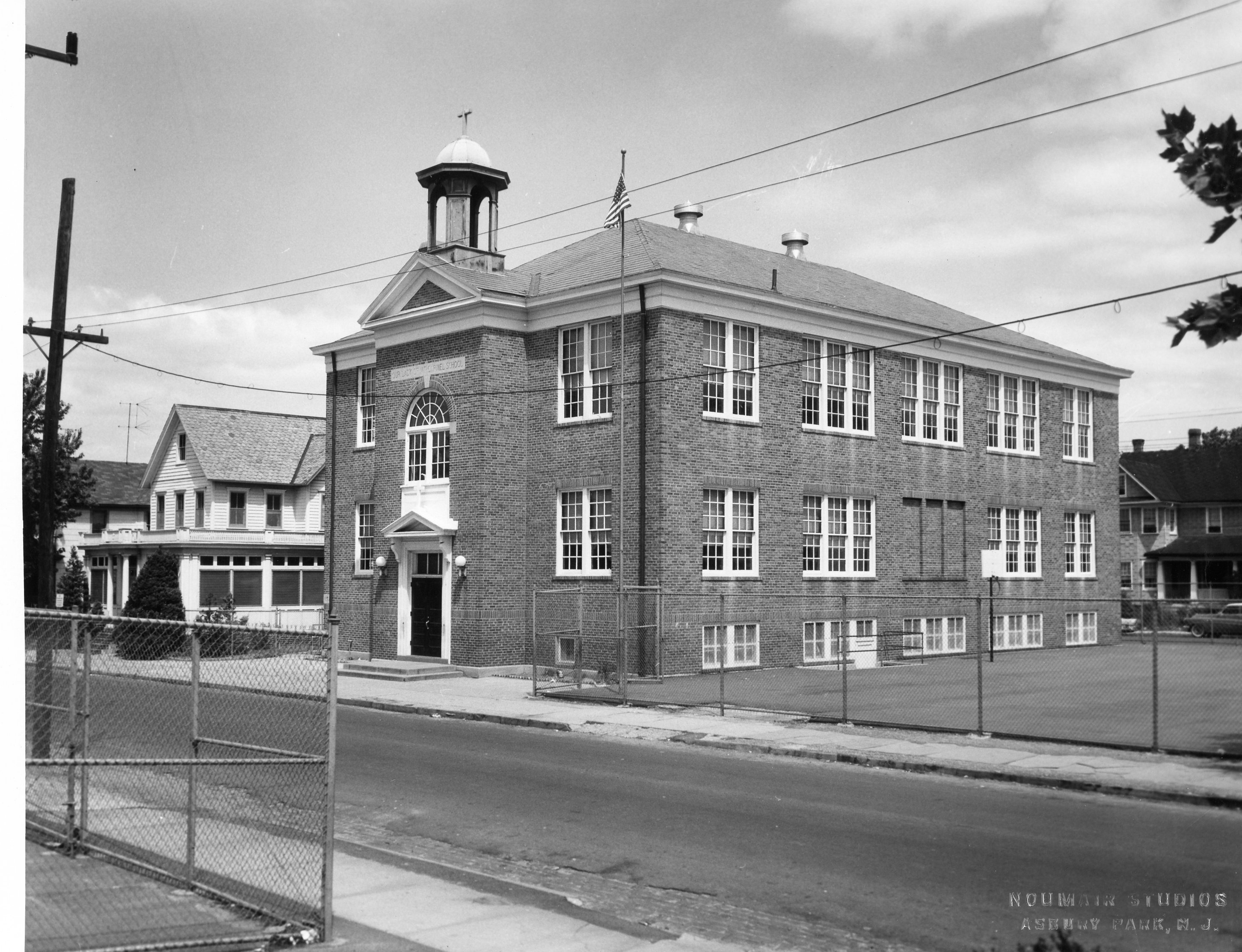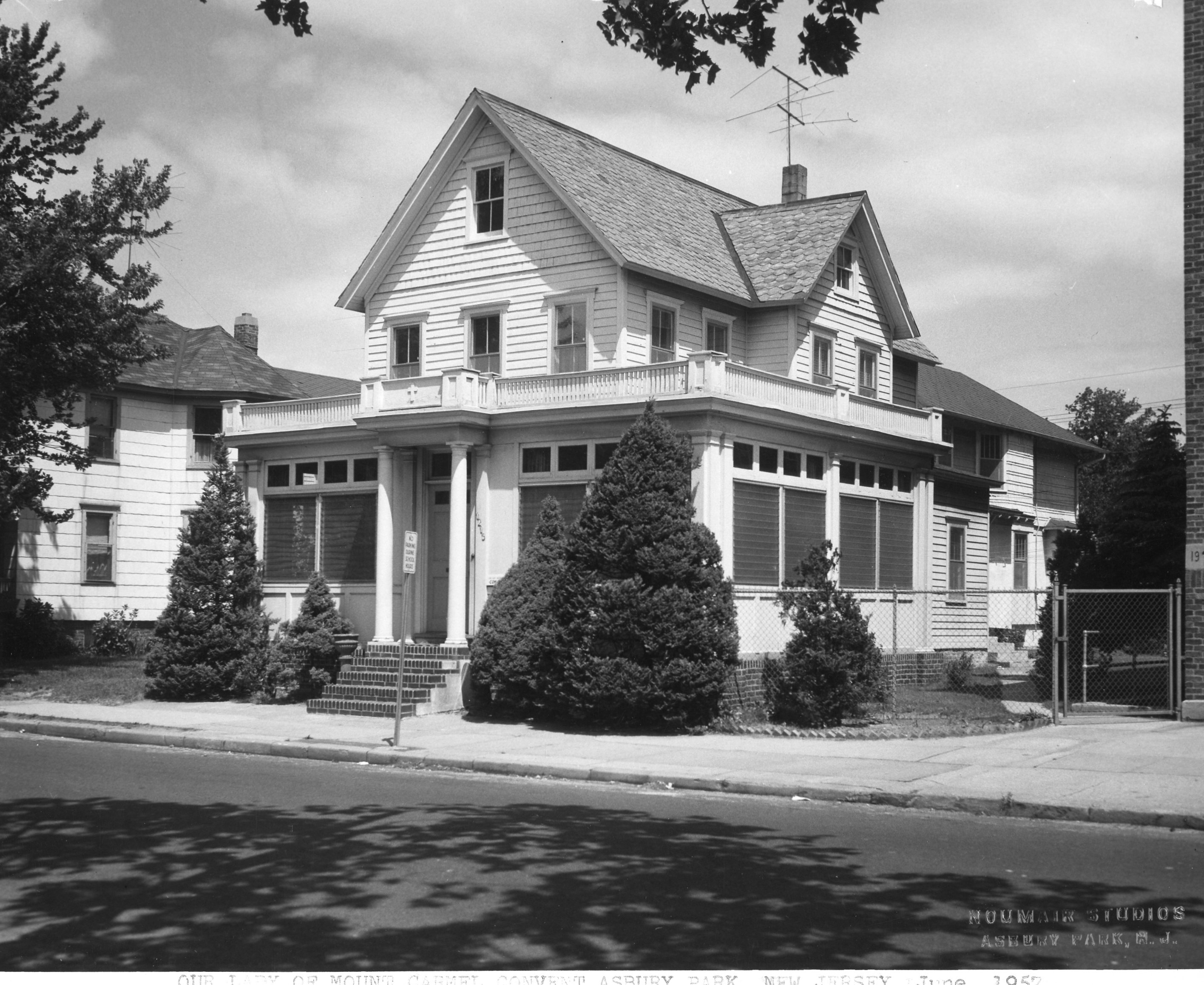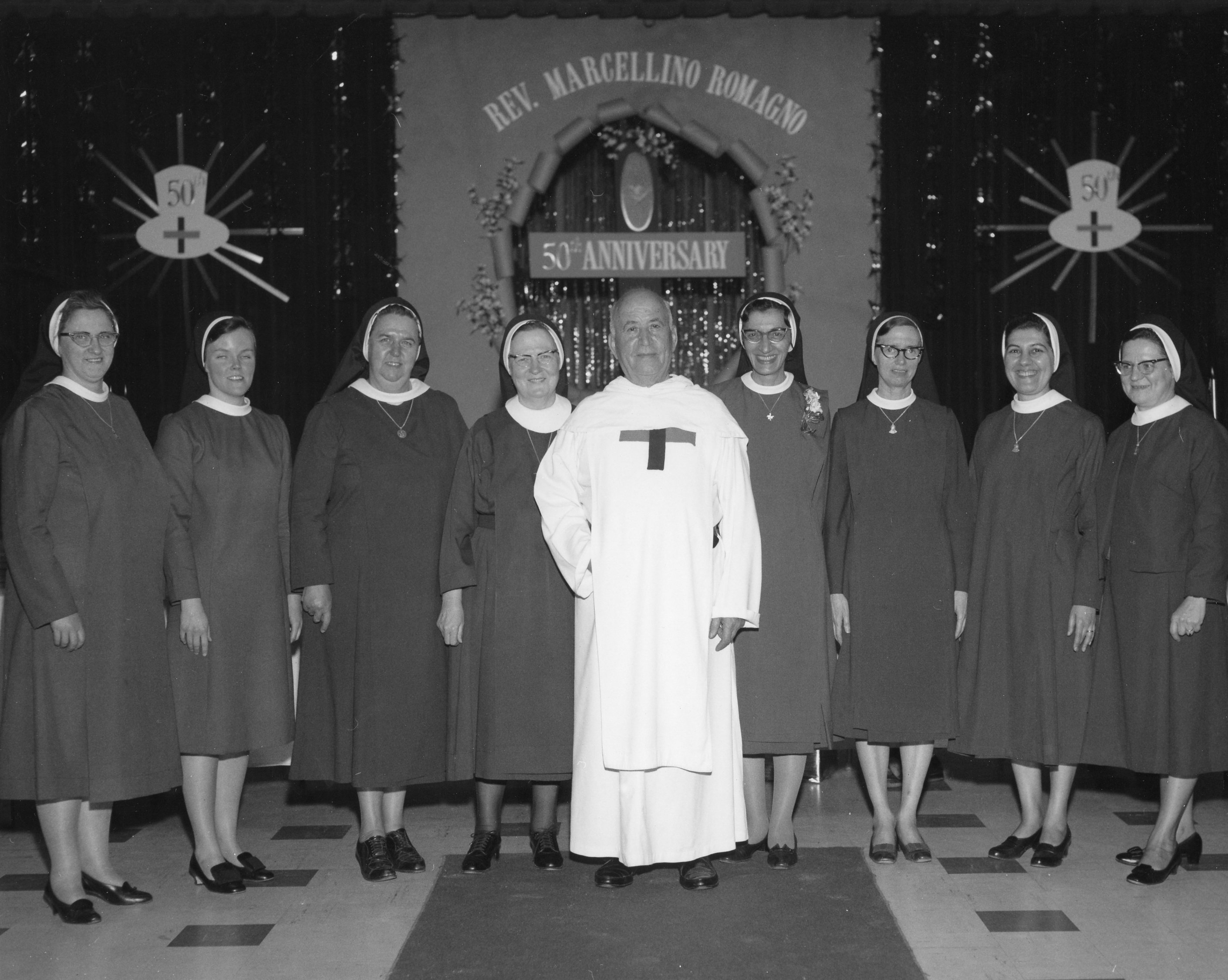Our Lady of Mount Carmel Elementary School, Asbury Park, New Jersey

Published by: RoseDog Books
Our Lady of Mount Carmel School in Asbury Park was the first venture of the Sisters of the Immaculate Heart of Mary in the Trenton, New Jersey Diocese. This parish was only thirty years old when our sisters came in 1934 and had been served by five different pastors during that period. The Trinitarian Fathers were invited by Bishop James McFaul of Trenton to serve the parish in 1912, and Reverend Anthony Giovannini, OSST, was appointed by his religious congregation. This zealous priest was fired with the missionary spirit that had taken him previously to assignments in Italian Somaliland in Africa, service as master of novices for the Trinitarians, and provincial for the congregation in Rome. His dreams for the development of the Italian parish of Our Lady of Mount Carmel were on a grand scale, but it was not until 1923 that he was able to construct the parochial school on Bangs Avenue. It was the basement of this structure that served as the parish church until the new church was built in 1951--fourteen years after his return to Rome, and ten years after his death in Rome in 1941. (43)
The Bangs Avenue school was originally placed under the charge of the Maestrine Philippini Sisters and later under the direction of the Missionary Sisters of the Sacred Heart. At the withdrawal of this latter group, it was Monsignor J. J. O'Hara of Bradley Beach, New Jersey, who suggested to Father Giovannini that he investigate obtaining the Sisters of the Immaculate Heart of Mary for his school. In considering this request, Mother Josepha must have discovered that the convent was actually too small for the number of sisters required and that extensive cleaning and painting were needed. Because of Father Anthony Giovannini's lack of facility in speaking and writing English, it was Monsignor O'Hara who conducted correspondence with Mother Josepha in regard to the sisters' coming. Evidently the enlargement of the convent had to be deferred because, as Monsignor O'Hara wrote, "Our Bishop is very happy to have you take care of Mount Carmel School. But he made . . . a rule not to permit one dollar of new debt anywhere. He explained to Father Giovannini that if the matter were placed before you that the Sisters would gladly make the best of the situation this year with the hope that conditions will clear up." (44) The "conditions" referred to, of course, were the economic depression condition that had caused so much suffering everywhere. True to her generous nature, Mother Josepha's reply indicated her willingness to send the sisters and to wait for the additional rooms until conditions might improve. (45)
Subsequent correspondence reveals, however, that even though general economic conditions improved, it would be a later pastor, and then only under direct orders from Bishop William A. Griffin of Trenton in August of 1946, who would join the convent to a house in the rear in order to provide adequate space for a chapel, community room, dining room and individual rooms for the sisters. (46)
The little community of four sisters who arrived by car in Asbury Park, New Jersey, on August 28, 1934, however, were not overly concerned about space. Sister Neumann Murray, superior and principal, Sister Liguori Farnon, Sister Mary John Bates and Sister Carmelita Charette entered upon their new mission with openness and a good sense of humor. Sister Neumann's account of their arrival and first evening at the convent reveals their pioneering spirit and their acceptance of the positive and negative aspects of the situation. Monsignor O'Hara of Bradley Beach, New Jersey, their benefactor from the first day, had provided a new Kelvinator frigidaire as a gift and had stocked it with butter, eggs, bacon and soft drink. The pastor arrived with bushel baskets of peppers, potatoes and tomatoes--as Sister Neumann commented, "The poor priests can't do enough for us . . . " It was evidently a setting in which it would be easy to practice poverty, as described by Sister Neumann:
"The five cells are very nice--the bed, chair and stand comprising the furniture. A small new rug at each bed, and a crucifix on the wall. Each bed was made up with two sheets, and a colored crinkly spread--blue, green, pink, lavender and yellow. No blankets, so we used our cloaks to keep us warm, and over them the new rugs. Even then we were freezing almost." (47)
 Our Lady of Mount Carmel Convent |
 IHM Sisters stationed at Our Lady of Mt. Carmel, circa 1968 |
With directness and foresight, Sister Neumann presented her needs to Mother Josepha: "I sincerely hope you'll be good enough to send us some cash to get started. The food, etc. is high here due to the aristocratic summer resort--and then too the three C.O.D. trunks from N. Carolina and one from Renovo will cost plenty . . ." (48)
But her hopeful attitude was an over-riding characteristic as she summed up the situation, "It will take time and money, but the place will be comfortable I'm sure. School will probably take the same." (49)
The pastor, Father Anthony Giovannini, proved to be most solicitous for the sisters' welfare, providing them with a weekly order of meat and other necessities to augment their thirty dollars per month per sister income. The Redemptorist Fathers, too, who came from St. Alphonsus Retreat House, West End, New Jersey, as confessors for the sisters, were very generous. They provided a new altar for the chapel, a dining room table, a community room table and chairs of light oak, and a set of Devonshire dinnerware. (50)
The school opened to 160 pupils in eight grades with ceremonial blessings of the classrooms and of new playground equipment. The meaningfulness of these blessings became better known to the sisters when they began to work with these youngsters. As Sister Neumann said, ''The youngsters evidently never knew discipline so we have our hands full . . . We have laughed for two weeks--but it is a reality just the same . . . I hope the examiners won't come here . . . I really think everything will come around in time, but it will take patience and hard work.” (51)
As an interior support for their arduous educational efforts the sisters brought their concerns to their common prayer together in their little chapel. The absence of the Blessed Sacrament was a keen spiritual suffering for them, so by October a letter was sent by Mother Josepha to Father Giovannini expressing her gratitude to him for all he was doing for the sisters, but urging him to approach the bishop for permission for the sisters to have the Blessed Sacrament in their chapel. She made a persuasive argument, saying,
"We have convents in three Archdioceses and nine Dioceses, and there has never been any question of denying the Sisters the great comfort of having the Blessed Sacrament in their chapels. If the sleeping room above the chapel interferes with this privilege, we will gladly close this room." (52)
This pastor's delay in this matter related to his reluctance to approach a very strict Bishop unless an emergency required it. However, later correspondence reveals his desire also to have the sisters very much present to the people of the parish. He wrote to Mother Josepha at one point asking that the sisters be permitted to receive Holy Communion on Sundays and holy days, as well as at daily Mass, in the church instead of in the convent "in order to encourage others and to give good example." (53)
Difficult as these beginning days at Mount Carmel may have been for our sisters, Father Anthony was most supportive of their work, and he and his priest assistants were generous with their time in giving instructions in religion throughout the school. One priest also taught Italian in the seventh and eighth grades and two of his pupils, the Capanelli twin boys, won a trip to Italy in 1934 for their fluency in Italian.
The children at Mount Carmel were naturally gifted in music and in art and were encouraged by Father Anthony who loved Italian operatic music and by Sister Carmelita, the music teacher, who prepared them for public entertainments. Prizes were also won by students for their work in art. The school rapidly became the focal point of parish activity. (54)
Whatever his idiosyncrasies, it must have been a sadness to everyone to see Father Anthony Giovannini leave Mount Carmel for Rome a few days after the parish celebration of the silver anniversary of his pastorate on February 17, 1937. He would spend the remaining four short years of his life in Rome. He died on December 8, 1941.
The new pastor, Father Marcellino Romagno, came to the parish in February 1938. At this time there were about 500 families in the parish so he realized that the old basement church was inadequate and that his first task was to build a new church. This goal was not achieved, however, until 1951, and five years later, in 1956, the adjacent rectory was completed. (55)
The school was gradually growing in size, with 354 pupils registered in the 1940s; by l962-1963, 550 pupils; and by 1966-1967, over 600. (56) Increasing numbers of pupils caused a concomitant increase in sister-teachers, causing in turn a need for enlarged school and convent facilities by 1962. The school that had been built in 1923 was not only too small, but was also showing its forty years of age. Repairs that were crucial were made to both the convent and the school, and gifts from benefactors, especially the Nicholas Aldarelli and Sam Scanio families, kept the sisters supplied with needed electrical appliances, vestments for the chapel and other necessities.
Groundbreaking for the new school and convent was held on July 1, 1962, with Reverend Marcellino Romagno, pastor, officiating. Construction of the twelve-room school actually started on August 27, 1962. The eighteen-room convent, with chapel, eleven bedrooms, community room, refectory, parlors, kitchen and laundry was begun on October 29, 1962.
As obedience would have it, Sister Georgina Wertz, who had served for six years as principal and superior, was transferred in June of 1961, and Sister Celesta Sinisi, who had served at Mount Carmel for fifteen years, was changed in June 1963, and appointed superior at East Stroudsburg, Pennsylvania. Sister Catherine Patricia McGirr was the new superior and principal in September 1963, when the new school and convent were opened. The dedication of these two new facilites took place on September 21, 1963, with Bishop George W. Ahr officiating, assisted by Father Romagno, pastor. The occasion was marked by Solemn Benediction and a dinner at which sisters who had previously served at Mount Carmel were present, together with the sisters from Holy Spirit and St. Peter Claver Parishes, and the priests from the area. (57)
Gradual changes in the nature of the parish affected the school enrollment which declined to 334 by 1973-1974; to 318 by 1982-1983 and to 288 in 1986-1987. Although smaller, the school continues its vibrant contribution to the Catholic education of the youth of Our Lady of Mount Carmel Parish.